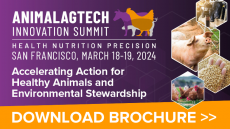Suppliers told to create a new 'language' around fishmeal

We caught up with Christine Delivanis, vice president, Marakon – Charles River Associates to hear more about the ideas behind differentiation and ways to add value to the fishmeal supply chain at the IFFO meeting in Washington, DC last month.
Fishmeal as a feed ingredient may be recognized as a high-quality ingredient, but there are challenges to its use stemming from inherent volatility and continuing questions on the environmental impact, she claimed.
“In my language, it’s because the supply is volatile, so for companies that are using this as an input, it becomes risky if it varies too much,” she said. “Prices kind of go up and down depending on what is happening with the catch.”
In light of these challenges, there has been material work and progress on the development and use of alternative feeds, she said.
Looking forward, it is possible to see a scenario where this type of substitution in feeds continues, or increases, and eventually even compresses fishmeal use and volumes, said Delivanis. “I know [it] is hard to imagine with a one-year-lens or a two-year-lens, but I think the dynamic suggests it is possible to happen over a longer-term perspective.”
Adapting to this situation is possible, if not necessarily easy, as it may require long-term investment and a different mindset regarding the nature of the product, she said.
In short, it may be time to think hard about how to migrate the product and its supporting value chain from a commodity-like space to a space of greater differentiation.
“That means the mindset moves from, we’re fighting over the pie, and we’re trying to squeeze each other, to we’re trying to grow a part of the pie and share the gains from that," said Delivanis.
It is looking at new ways of talking about the product, consumer considerations and changing the relationship between producers and feed manufacturers, she said.
The language of differentiation
One way to address the use of fishmeal as a feed ingredient is to start treating the feed ingredient differently, said Delivanis.
The path towards differentiation may involve creating a new 'language' around fishmeal by specifying what use or benefit the ingredient has for end consumers, she said. One example of this is the change in how coffee is marketed.
“I know coffee is not an ingredient, coffee is a product,” she said. “However, not that long ago coffee was coffee. If you think about what’s happened to the complexity of the language that’s been introduced to talk about coffee, whether it’s where it comes from, what the bean is, what the blend is, how it’s roasted, how it’s used and delivered, to what it tastes like – it’s created a huge range of options that people can draw on."
For salmon or fish producers, one way to speak with consumers would be to discuss either the origins or processing mechanics around feed, she said. “In the world of livestock, in the world of chicken, consumers want to know what these animals are eating [and] it’s coming to fish – it’s inevitable,” she added.
Creating the value chain
However, there are also common challenges that companies can experience when attempting to move to, or create, a value-added supply chain, and establishing a separate management system for the value-added segment of the business may reduce some of those challenges, she said.
“If you separate the two markets out you will find you can manage them differently,” she said. “You will find that you’ll allow yourself a higher cost basis on the differentiated side that you’ll recoup on higher pricing."
Another practice that may be of use for producers is to work with other members of the supply chain, said Delivanis.
“There may be a benefit of thinking about virtual networks or there may be a benefit of setting up small scale innovation hubs in certain areas that are attractive because they bring you close to the end consumer,” she added.















